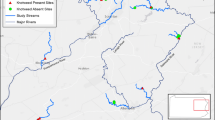Abstract
Common reed is increasingly harvested from the Mediterranean region toprovide thatching material to north European countries. The impact of thesemanagement practices on the fauna is poorly known. The aim of this study was toquantify the effect of reed cutting in the Mediterranean region through acomparative analysis of water regime, vegetation structure, arthropoddistribution and passerine assemblage at cut and uncut reedbeds in southernFrance. Cut reedbeds were characterised by a lower salinity, higher water levelin spring, and higher reed biomass than uncut reedbeds. Arthropod distributiondiffered consistently between cut and uncut sites, leading to a higher index offood available to passerines in cut reedbeds. Cut reedbeds had a similar birdspecies richness but a lower bird abundance, due to the significant decrease inMoustached Warblers and Bearded Tits at cut sites. The mild Mediterranean winterfavoured early growth of reed in spring, making harvested reedbeds suitable forbreeding of long-distance migrants such as the Great Reed Warbler and ReedWarbler. However, for the resident species that breed earlier in the season, cutreedbeds presumably lack sufficient vegetation cover to provide adequate nestingand feeding sites. Although biennial cutting (double wale) is considered as agood compromise between conservation and commercial interests in the UK, thejuxtaposition of annually cut and never cut reed patches appears as the onlysustainable alternative for the Mediterranean region. We further hypothesisethat an optimal mosaic design of cut/uncut reed patches could provide as high aconservation value as unmanaged reedbeds.
Similar content being viewed by others
References
Andrews R. 1992. Establishment and management to produce reeds for thatching. In: Ward D. (ed.), Reedbeds for Wildlife. Information Press, Oxford.
Andrews R. and Ward D. 1991. The management and creation of reedbeds especially for rare birds. British Wildlife 3: 81–91.
Baldi A. and Moskat C. 1995. Effect of reed burning and cutting on breeding bird communities. In: Bissonette J.A. and Krausman P.R. (eds), Integrating People and Wildlife for a Sustainable Future. Allen Press, Lawrence, Kansas, pp. 637–642.
Bibby C.J. and Green R.E. 1981. Autumn migration strategies of reed and sedge warblers. Ornis Scandinavica 12: 1–12.
Bibby C.J. and Lunn J. 1982. Conservation of reed beds and their avifauna in England and Wales. Biological Conservation 23: 167–186.
Burgess N.D. and Evans C.E. 1989. The Management of Reedbeds for Birds. Information Press, Oxford.
Cowie N.R., Sutherland W.J., Ditlhogo M.K.M. and James R. 1992. The effects of conservation management of reed beds. II. The flora and litter disappearance. Journal of Applied Ecology 29: 277–284.
Decleer K. 1990. Experimental cutting of reedmarsh vegetation and its influence on the spider (Araneae) fauna in the Blankaart Nature Reserve, Belgium. Biological Conservation 52: 161–186.
Dick G., Dvorak M., Grüll A., Kohler B. and Rauer G. 1994.Vogelparadies mit Zukunft? Umweltbundesamt, Vienna.
Goc M., Iliszko L. and Kopiec K. 1997. The effect of reed harvesting on reedbed bird community. ring 19: 135–148.
Grandio J.M. 1999. Differential autumn migration of sedge warblers (Acrocephalus schoenobaenus) through the Txingudi marsh (northern Spain). Ardeola 46: 171–178.
Granéli W. 1989. Influence of standing litter on shoot production in reed, Phragmites australis (Cav. Trin. ex Steudel). Aquatic Botany 35: 99–109.
Graveland J. 1999. Effects of reed cutting on density and breeding success of reed warbler Acrocephalus scirpaceus and sedge warbler Acrocephalus schoenobaenus. Journal of Avian Biology 30: 469–482.
Grüll A. and Zwicker E. 1993. Zur Siedlungsdichte von Schilfsingvögeln (Acrocephalus und Locustella) am Neusiedler See in Abhängigkeit vom Alter der Röohrichtbestände. Beitrage zu den Veröffen tlichungen für Naturschutz und Landschaftspflege in Baden-Württemberg 68: 159–172.
Hawke C.J. and José P.V. 1996. Reedbed Management for Commercial and Wildlife Interests. RSPB, Sandy, UK.
Hellings S.E. and Gallagher J.L. 1992. The effects of salinity and flooding on Phragmites australis. Journal of Applied Ecology 29: 41–49.
Kube J. and Probst S. 1999. Bestandsabnahme bei schilfbewohnenden Vogelarten an der südlichen Ostseeküste: Welchen Einfluβ hat die Schilfmahd auf die Brutvogeldichte? Vogelwelt 120: 27–38.
Leisler B., Ley H.W. and Winkler H. 1989. Habitat, behavior and morphology of Acrocephalus warblers: an integrated analysis. Ornis Scandinavica 20: 181–186.
Lissner J. and Schierup H.H. 1997. Effects of salinity on the growth of Phragmites australis. Aquatic Botany 55: 247–260.
Mathevet R. 2000. Usages des zones humides camarguaises: Enjeux et dynamique des interactions Environment/Usagers/ Territoire, Ph.D. Thesis, Université Jean Moulin Lyon 3, Lyon.
Mauchamp A. 1998. Caractérisation des roselières mediterranéennes: resultats et analyses d'un an de suivi. Rapport interne Station Biologique de la Tour duValat, Arles, France.
Ostendorp W. 1987. Die Auswirkungen von Mahd und Brand auf die Ufer-Schilfbestände des Bodensee-Untersees. Natur und Landschaft 62: 99–102.
Poulin B. and Lefebvre G. 1997. Estimation of arthropods available to birds: effect of trapping technique, prey distribution, and bird diet. Journal of Field Ornithology 68: 426–442.
Poulin B., Lefebvre G. and Metref S. 2000a. Spatial distribution of nesting and foraging sites of two Acrocephalus warblers in a Mediterranean reedbed. Acta Ornitologica 35: 117–121.
Poulin B., Lefebvre G. and Pilard P. 2000b. Quantifying the breeding assemblage of reedbed passerines with mist-net and point-count surveys. Journal of Field Ornithology 71: 443–454.
Poulin B., Lefebvre G. and Mauchamp A. 2002. Habitat requirements of passerines and reedbed management in Southern France. Biological Conservation (in press).
Rocamora G. and Yeatman-Berthelot D. (1999) Oiseaux menacés et à surveiller en France. Listes rouges et recherche de priorités. Populations. Tendances. Menaces. Conservation. Société d'Études Ornithologiques de France (SEOF) and Ligue pour la Protection des Oiseaux (LPO), Paris.
Schmidt M. 2000. Der Einfluss der Mahd auf Arthropoden und Singvægel in Schilfbeständen, Diplomar-beit Thesis, University of Gottingen, Göttingen, Germany.
Ward D. 1992a. Management of reedbeds for wildlife. In: Ward D. (ed.), Reedbeds for Wildlife. Information Press, Oxford, pp. 65–78.
Ward D. 1992b. Reedbeds for Wildlife. RSPB, University of Bristol. Information Press, Oxford.
Author information
Authors and Affiliations
Rights and permissions
About this article
Cite this article
Poulin, B., Lefebvre, G. Effect of winter cutting on the passerine breeding assemblage in French Mediterranean reedbeds. Biodiversity and Conservation 11, 1567–1581 (2002). https://doi.org/10.1023/A:1016866116220
Issue Date:
DOI: https://doi.org/10.1023/A:1016866116220




